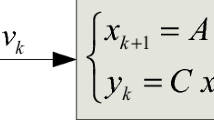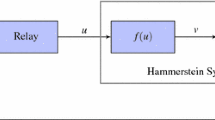Abstract
This paper introduces Preisach model to describe hysteretic input nonlinearities of extended Hammerstein systems. Preisach model is proved to be an effective model to cover most of hysteretic input nonlinearities studied in the existing literatures on identification of extended Hammerstein systems. That is, Preisach model encloses the backlash-type nonlinearities and the hysteresis-relay nonlinearities as special cases, but excludes the switch-type nonlinearities. Hence, the usage of Preisach model is able to resolve an issue that types of hysteretic input nonlinearities are often inaccessible in practice, but most of existing identification methods have to know the type of input hysteretic nonlinearity a priori. For identification of extended Hammerstein systems with input nonlinearity described by Presiach model, the persistently exciting (PE) condition of input is established and the consistency of estimated model parameters is proved. In particular, the requirement on inputs to meet with the PE condition covers a wide class of signals, which resolves another issue in the existing studies that specially designed inputs are usually required. Numerical and industrial examples are provided to illustrate the obtained results.












Similar content being viewed by others
Notes
In fact, most of the existing literatures on identification of extended Hammerstein systems are focused on the backlash-type and hysteresis-relay nonlinearities, not on the switch-type nonlinearities.
References
Bai, E.W.: An optimal two-stage identification algorithm for Hammerstein–Wiener nonlinear systems. Automatica 34(3), 333–338 (1998)
Bai, E.W.: Identification of linear systems with hard input nonlinearities of known structure. Automatica 38(5), 853–860 (2002)
Bai, E.W.: Discussion on: “Subspace-based identification algorithms for Hammerstein and Wiener models”. Eur. J. Control 11(2), 137–138 (2005)
Bai, E.W., Li, K.: Convergence of the iterative algorithm for a general Hammerstein system identification. Automatica 46(11), 1891–1896 (2010)
Banks, H.T., Kurdila, A.J., Webb, G.: Identification of hysteretic control influence operators representing smart actuator part I: formulation. Math. Probl. Eng. 3(4), 287–328 (1997)
Brokate, M., Sprekels, J.: Hysteresis and Phase Transitions. Springer, New York (1996)
Cerone, V., Regruto, D.: Bounding the parameters of linear systems with input backlash. IEEE Trans. Autom. Control 52(3), 531–536 (2007)
Chan, K.H., Bao, J., Whiten, W.J.: Identification of MIMO Hammerstein systems using cardinal spline functions. J. Process Control 16(7), 659–670 (2006)
Chang, F., Luus, R.: A noniterative method for identification using Hammerstein model. IEEE Trans. Autom. Control 16(5), 464–468 (1971)
Chen, T., Ohlsson, H., Ljung, L.: On the estimation of transfer functions, regularizations and Gaussian processes—revisited. Automatica 48(8), 1525–1535 (2012)
Cheng, Y.C., Yu, C.C.: Relay feedback identification for actuators with hysteresis. Ind. Eng. Chem. Res. 39(11), 4239–4249 (2000)
Giri, F., Bai, E.W. (eds.): Block-Oriented Nonlinear System Identification. Springer, Berlin (2010)
Giri, F., Rochdi, Y., Brouri, A., Chaoui, F.Z.: Parameter identification of Hammerstein systems containing backlash operators with arbitrary-shape parametric borders. Automatica 47(8), 1827–1833 (2011)
Giri, F., Rochdi, Y., Chaoui, F.Z., Brouri, A.: Identification of Hammerstein systems in presence of hysteresis-backlash and hysteresis-relay nonlinearities. Automatica 44(3), 767–775 (2008)
Haber, R., Keviczky, L.: Nonlinear System Identification: Input–Output Modeling Approach. Kluwer Academic Publishers, Dordrecht (1999)
Iyer, R.V., Shirley, M.E.: Hysteresis parameter identification with limited experimental data. IEEE Trans. Magn. 40(5), 3227–3239 (2004)
Ljung, L.: System Identification: Theory for the User, 2nd edn. Prentice Hall, Englewood Cliffs (1999)
Mayergoyz, I.D.: Mathematical models of hysteresis. Phys. Rev. Lett. 56(15), 1518–1521 (1986)
Mayergoyz, I.D.: Mathematical Models of Hysteresis and Their Applications, 2nd edn. Academic Press, London (2003)
Miyashita, N., Yamakita, M.: Identification of Hammerstein systems with piecewise nonlinearities with memory. In: Proceedings of 46th IEEE Conference on Decision and Control, pp. 5749–5754. New Orleans, LA, USA, Dec 12–14 (2007)
Pillonetto, G., Dinuzzo, F., Chen, T., Nicolao, G.D., Ljung, L.: Kernel methods in system identification, machine learning and function estimation: a survey. Automatica 50(3), 657–682 (2014)
Rochdi, Y., Giri, F., Gning, J.B., Chaoui, F.Z.: Identification of block-oriented systems in the presence of nonparametric input nonlinearities of switch and backlash types. Automatica 46(5), 864–877 (2010)
Shirley, M.E., Venkataraman, R.: On the identification of Preisach measures. Smart Struct. Mater. 5049, 326–336 (2003)
Söderström, T., Stoica, P.: System Identification. Prentice Hall, Englewood Cliffs (1989)
Stoica, P., Söderström, T.: Instrumental-variable methods for identification of Hammerstein systems. Int. J. Control 35(3), 459–476 (1982)
Tan, X., Baras, J.S.: Adaptive identification and control of hysteresis in smart materials. IEEE Trans. Autom. Control 50(6), 827–839 (2005)
Tjärnström, F., Ljung, L.: Variance properties of a two-step ARX estimation procedure. Eur. J. Control 9(4), 422–430 (2003)
Visintin, A.: Differential Models of Hysteresis. Springer, New York (1994)
Vörös, J.: Modeling and identification of systems with backlash. Automatica 46(2), 369–374 (2010)
Vörös, J.: Recursive identification of nonlinear cascade systems with time-varying general input backlash. J. Dyn. Syst. Meas. Control 135, 014,504-1 (2013)
Wang, J., Sano, A., Chen, T., Huang, B.: Identification of Hammerstein systems without explicit parameterisation of non-linearity. Int. J. Control 82(5), 937–952 (2009)
Wang, J., Zhang, Q., Ljung, L.: Revisiting Hammerstein system identification through the two-stage algorithm for bilinear parameter estimation. Automatica 45(11), 2627–2633 (2009)
Zhu, Y.: Multivariable System Identification for Process Control. Elsevier Science, Oxford (2001)
Acknowledgments
This research was partially supported by the National Natural Science Foundation of China under grants No. 61074105 and No. 61061130559, and by the French ANR EBONSI project.
Author information
Authors and Affiliations
Corresponding author
Appendices
Appendix 1: Representation theorem
This appendix recalls the Representation Theorem established by Mayergoyz [18] that gives a sufficient and necessary condition for the hysteresis-type nonlinearities that can be represented by Preisach model:
Theorem 1
(Representation Theorem) [18] The wiping-out property and the congruency property constitute the necessary and sufficient condition for a rate-independent hysteresis nonlinearity to be represented by Preisach model on the set of piecewise continuous inputs.
The three properties in Theorem 1 are defined as follows:
Property 1
(Wiping-out property) [19] (pp. 15–17 therein) Only the series of dominant input extrema are stored by Preisach model, and all other input local extrema are wiped out.
Property 2
(Congruency property) [19] (pp. 18–19 therein) All hysteresis loops corresponding to the same extreme values of input are congruent in the geometric sense (i.e., the loops are identical up to translation).
Property 3
(Rate-independence property) [28] (p. 13 therein) The hysteresis nonlinearity output is invariant to any increasing time homeomorphism (i.e., the output is independent to the variation velocity of the input).
Appendix 2: First-order reversal function
This appendix serves to recall the first-order reversal function defined in [19].
First, the geometric interpretation of Preisach model is a useful tool [18, 19]. Define two sets \(S^+(t)\), \(S^-(t)\) and one memory curve \(L(t)\) as follows:
-
\(S^+(t)\) consists of all the points \((\beta , \alpha )\) for which the relay operator \(\gamma _{\beta \alpha }(t) = 1\) at the time instant \(t\);
-
\(S^-(t)\) consists of all the points \((\beta , \alpha )\) for which \(\gamma _{\beta \alpha }(t) = -1\) at the time instant \(t\);
-
\(L(t)\) is the boundary line between \(S^+(t)\) and \(S^-(t)\).
With the sets \(S^+(t)\) and \(S^-(t)\), Preisach model in (3) can be equivalently represented as
Second, the first-order descending reversal function is formulated as the path of \(f(t)\) for a monotonic increment of \(u(t)\) starting from the minimum value \(u_\mathrm{{min}}\) to the value \(\alpha '\) followed by a subsequent monotonic decrement to \(\beta '\); the corresponding \(\alpha -\beta \) diagram is shown in Fig. 13. Denote \(f_{\alpha '}\) and \(f_{\alpha ', \beta '}\) as the output values of \(f(t)\) in (42) for \(u(t) = \alpha '\) and \(u(t)=\beta '\), respectively. The so-called Everett function is defined as [18],
It is revealed from the \(\alpha -\beta \) diagrams in Fig. 13 that the triangle \(T(\beta ',\alpha ')\) with three vertices \((\beta ', \beta ')\), \((\alpha ', \alpha ')\) and \((\beta ', \alpha ')\) is added to the negative set \(S^-\) and subtracted from the positive set \(S^+\), when \(u(t)\) is monotonically decreased from \(\alpha '\) to \(\beta '\). From (42) and (43), we have
Thus, the weighting function \(\mu (\beta ', \alpha ')\) can be determined by differentiating \( F(\beta ', \alpha ')\) with respect to \(\beta '\) and \(\alpha '\), i.e.,
Rights and permissions
About this article
Cite this article
Fang, L., Wang, J. & Zhang, Q. Identification of extended Hammerstein systems with hysteresis-type input nonlinearities described by Preisach model. Nonlinear Dyn 79, 1257–1273 (2015). https://doi.org/10.1007/s11071-014-1740-3
Received:
Accepted:
Published:
Issue Date:
DOI: https://doi.org/10.1007/s11071-014-1740-3





